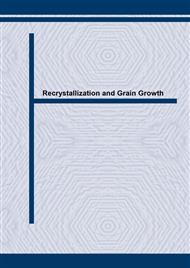p.141
p.147
p.153
p.159
p.165
p.171
p.177
p.183
p.189
On the Production of Randomly-Oriented Recrystallization Nuclei for Selective Growth Experiments
Abstract:
The ideal starting condition for selective growth experiments is one having a layer of randomly-oriented nuclei adjacent to a matrix with negligible orientational variation but sufficient stored energy to promote growth. In practice, cutting or deformation processes are used in an attempt to approximate these ideal conditions, but the degree to which this is achieved has not been rigorously quantified. In this work, Fe-3wt%Si single crystals were cut or deformed using six different processes. The variation in texture with distance from the cut or deformed surface was measured using electron backscatter diffraction (EBSD) in a field emission gun scanning electron microscope (FEG-SEM) in order to assess the ability of each process to create conditions suitable for selective growth experiments. While grooving with a machine tool produced the best spread of orientations at the cut surface, the suitability of this process is diminished by the presence of a differently-textured deformed layer between the cut surface and the single crystal matrix. Grinding produced a less ideal distribution of orientations at the cut surface, but the presence of these orientations in a very thin layer adjacent to the matrix makes this process preferable for preparing crystals for selective growth experiments, provided the results are corrected for the deviation in the distribution of nuclei orientations from a random distribution.
Info:
Periodical:
Pages:
165-170
Citation:
Online since:
October 2004
Authors:
Keywords:
Price:
Сopyright:
© 2004 Trans Tech Publications Ltd. All Rights Reserved
Share:
Citation:


